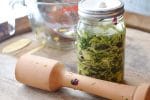Description
This quick and easy sauerkraut recipe begins with a 20 ounce bag of sweet kale salad mix. You won’t use the dressing or the cello bag of pumpkin seeds and cranberries. Save those for another salad. The only other ingredient you’ll need is some Himalayan salt.
Ingredients
Scale
- 1 28 ounce bag of Sweet Kale Salad Mix
- 2 teaspoon Himalayan salt, fine grain
Instructions
- Empty the salad bag into a colander and rinse the salad greens. Let them drain naturally for 15 minutes, or spin in a salad spinner. Set aside the enclosed salad dressing and pumpkin seed/cranberry garnish for another recipe.
- Place the washed salad greens into a bowl. Sprinkle salt over the salad greens.
- Pound with a kraut pounder until the salad greens are well bruised and the juices begin to flow.
- Transfer the salad greens to a sanitized quart jar. Press down with the kraut pounder. Add water to cover the greens.
- Place sanitized glass weight into the mouth of the jar. Press down so that the liquid in the jar comes over the top of the glass weight. Place fermentation lock in the top of the jar and secure in place with the screw bad. Set on a plate to catch any overflow. Place out of direct sunlight and heat so that it can ferment naturally. There is no need to add any probiotic culture to the jar. The culture needed to ferment the cabbage is already on the outside of the vegetables.
- After 24 to 48 hours the vegetables in the jar will begin to bubble. The pressure inside the jar will build up and the silicone lid will bulge up on the top of the jar. During this time the liquid in the jar becomes more acidic and 3 different beneficial bacteria colonize the jar and then die off. In the final act, the pressure in the jar reduces and the lacto-bacteria have finished colonizing the jar. The fermentation can now be moved to develop flavors.
- Remove the fermentation weight and the silicone fermentation lock. Replace the lid on the jar with a normal lid. Refrigerate the jar or move it to a cool, dark room to finish developing complex flavors or eat immediately.
- Sauerkraut will keep up to a year in the fridge. Do not eat if mold develops on the surface of the jar or if the jar smells “off” or putrid.
Notes
The high acidity of sauerkraut prevent botulism from growing in the jar. A milky yeast can grow in jars of fermented vegetables. This yeast is not harmful and doesn’t affect the safely of fermented vegetables. However it can affect the flavor and the presentation.
